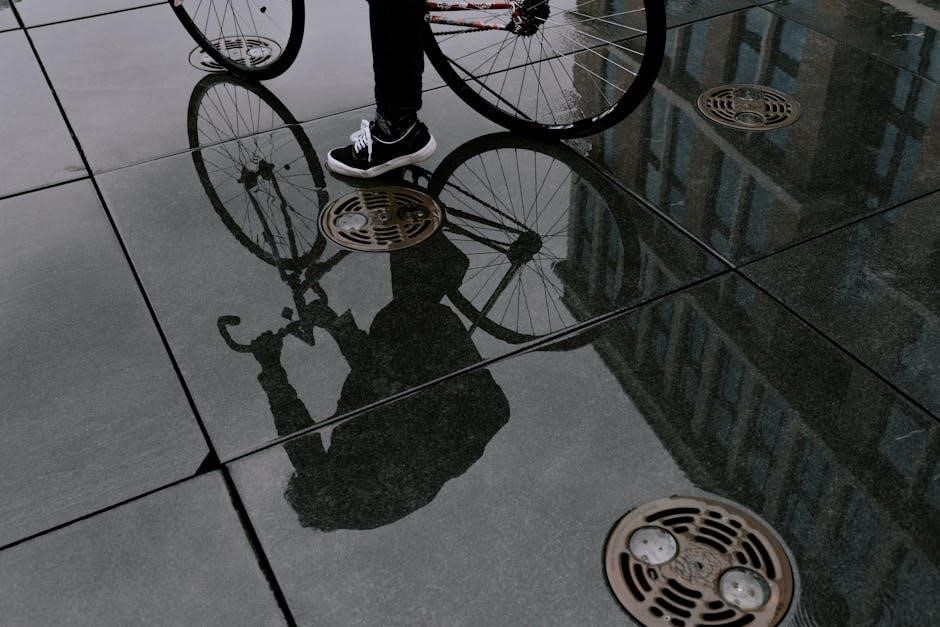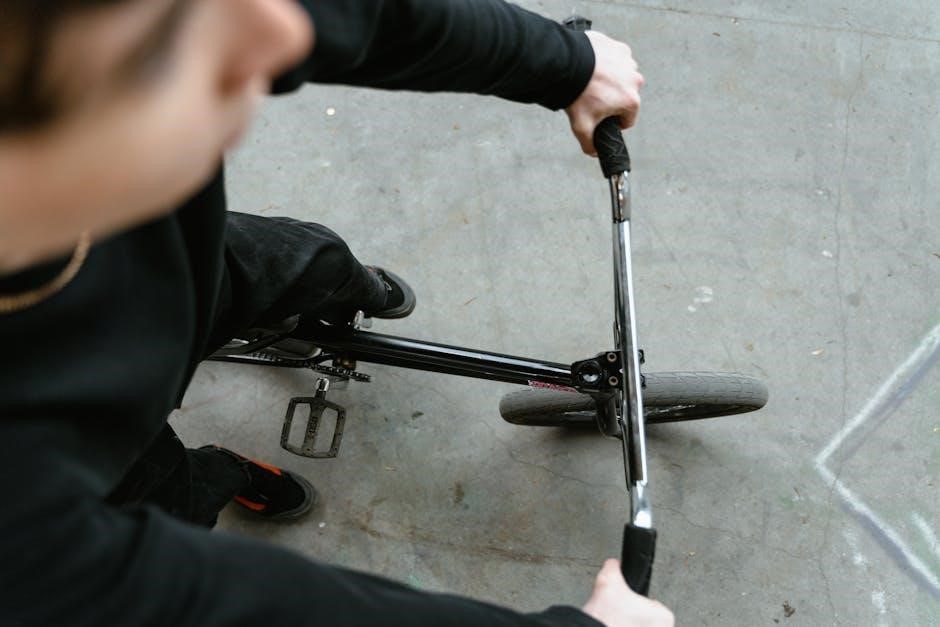Proper fit is essential for performance and comfort. Cycling shoe sizing varies by brand and style, requiring careful consideration. This guide helps you navigate the process effectively.
Key Considerations for Choosing the Right Size
When selecting cycling shoes, ensure a snug fit for optimal performance and comfort. Avoid overly tight shoes, as they can restrict circulation and cause discomfort during long rides. Consider the difference between road and mountain bike shoes, as their fits vary slightly. Measure your foot accurately, adding 5mm to your length for comfort. Check the brand’s sizing chart, as sizes can differ. If between sizes, opt for the larger one for better comfort. Width options are crucial, with standard, wide, and custom fits available. Personal preference plays a significant role, so try shoes on if possible. Proper fit ensures efficiency, support, and reduces the risk of discomfort or injury while cycling.

Understanding Bike Shoe vs. Regular Shoe Sizing
Bike shoes often run true to size but differ in fit due to stiffer soles and snug designs. They prioritize support over casual comfort, requiring precise sizing for optimal performance.
Differences in Fit and Measurement
Bike shoes are designed for performance, featuring stiffer soles and a snug fit compared to regular shoes. They often have a more precise sizing system, emphasizing length and width measurements. While regular shoes may allow for a looser fit, cycling shoes prioritize support and efficiency, requiring accurate foot measurement. The shape and volume of the foot play a crucial role, as improper fit can lead to discomfort or reduced performance. Brands may also vary in their sizing standards, making it essential to consult specific size charts. This ensures the best possible fit for optimal comfort and cycling efficiency.
How to Measure Your Foot Accurately
To measure your foot accurately, place it flat on paper, trace the outline, and measure the longest and widest points. Convert measurements to centimeters for sizing accuracy.
Step-by-Step Guide to Foot Measurement
To ensure accurate foot measurement, follow these steps:
- Place a sheet of paper on a flat surface and stand on it with your foot.
- Trace the outline of your foot using a pencil, ensuring the foot is relaxed.
- Measure the longest point (heel to toe) and the widest point using a ruler or measuring tape.
- Record the measurements in centimeters for consistency with cycling shoe size charts.
- Compare your measurements to the brand-specific sizing guides to determine your ideal fit.
Accurate measurements are crucial for selecting the right cycling shoe size, ensuring comfort and optimal performance.

Size Chart Comparison: European, US, and UK Sizes
European, US, and UK sizes differ in cycling shoes. For example, a European size 36 corresponds to US 4 and UK 3.5, varying slightly by brand.
Always refer to the specific brand’s size chart for accurate conversions to ensure the best fit for your cycling needs.
Converting Sizes Across Different Regions
Converting cycling shoe sizes between European, US, and UK standards requires careful attention to ensure accuracy. European sizes are typically larger than US and UK sizes by about 33-35%. For example, a European size 36 corresponds to a US size 4 and a UK size 3.5. To convert, use a reliable size chart specific to the brand, as variations exist. Measure your foot in centimeters and compare it to the chart for the best fit. Always check the brand’s sizing guide, as some may differ slightly. Accurate conversion ensures comfort and performance while cycling, preventing issues like tightness or slippage during rides.

Brand-Specific Sizing Guides
Each cycling shoe brand offers unique sizing charts. SIDI, Shimano, and Specialized provide detailed guides to ensure accurate fit based on their specific shoe designs and measurements.
SIDI Cycling Shoe Size Chart
SIDI cycling shoes use European sizing, with conversions to US and UK sizes. Their size chart typically ranges from EUR 36 (US 4, UK 3) to EUR 51 (US 16, UK 15), corresponding to foot lengths of 22cm to 32.7cm. Each size increases by approximately 0.3cm in length. For example, EUR 37 (US 5, UK 4) measures 23cm, while EUR 38 (US 6, UK 5) measures 23.3cm. SIDI also offers a “Regular Fit” and “Mega Fit” for wider feet. To ensure accuracy, compare your foot measurement to their chart, as sizes may vary slightly by model. Always check SIDI’s official size guide for the most precise fit.
Shimano Cycling Shoe Size Conversion
Shimano cycling shoes primarily use European sizing, requiring conversion for UK and US standards. For example, a UK size 7 corresponds to a European size 41, while a US size 8 aligns with European size 42. The conversion chart typically progresses in increments of one European size per UK or US size. To ensure a precise fit, measure your foot length and add 5mm for comfort, then match it to Shimano’s size chart. Their shoes are designed to be snug yet comfortable, offering support for optimal performance. Always refer to Shimano’s official size guide for accurate conversions and the best fit.
Specialized Cycling Shoe Measurements
Specialized cycling shoes offer precise sizing options, with a detailed size chart that includes Euro, USA, UK, and CM measurements. For example, a Euro size 35 corresponds to a USA 3.5, UK 2.5, and 22.5cm foot length. The chart progresses incrementally, ensuring accurate fit. Specialized also offers a ‘Comfort Plus Width’ option, adding 5mm to the measured foot length for a snug yet comfortable fit. Their road shoes, such as the CX201, and MTB shoes, like the TX224 (Wide), cater to different cycling disciplines. Refer to Specialized’s official size guide for the most accurate measurements and to find the perfect fit for your cycling needs.

How to Choose the Right Fit
Selecting the right fit ensures comfort and performance. Opt for snugness without constriction, allowing slight toe movement. Consider foot shape, riding style, and brand-specific sizing for optimal comfort.
Snug vs. Comfortable: Finding the Perfect Balance
A proper fit balances snugness and comfort. Cycling shoes should feel secure to optimize power transfer and support, but overly tight shoes can cause discomfort or numbness. Aim for a fit where your foot feels held firmly but not constricted; Toes should have minimal room to wiggle, preventing pressure points. Heel movement should be minimal to avoid blisters. Consider the shape of your foot and the shoe’s volume when choosing. If you’re between sizes, opt for the snugger fit for performance or the looser for comfort, depending on your riding style. Testing shoes in the afternoon, as feet swell during the day, ensures the best fit. Wearing cycling socks can also help achieve the right balance.

Width Options and Their Importance
Width options ensure optimal comfort and performance. Standard, wide, and custom fits cater to different foot shapes, providing support and preventing discomfort during rides. Proper width enhances efficiency.
Standard, Wide, and Custom Fit Options
Standard widths suit most riders, offering a balance of support and comfort. Wide options accommodate broader feet, reducing pressure and discomfort. Custom fits, available from some brands, are tailored to individual foot shapes. They ensure precise support and optimal performance. Proper width is crucial for preventing issues like toe rub or heel slippage. Riders with standard foot volume find comfort in regular widths, while those needing extra space benefit from wide options. Custom fits are ideal for unique foot shapes, enhancing both comfort and efficiency during rides. Choosing the right width ensures a better cycling experience.

Maintenance Tips for Bike Shoes
Regularly clean shoes with mild soap and water. Allow them to air dry to prevent odor and mold. Use protective sprays to extend durability and water resistance.
Extending the Life of Your Cycling Shoes
To ensure your cycling shoes last longer, start with a proper fit. Avoid tight shoes that can cause excessive wear on the materials. Clean them regularly using mild soap and water, and let them air dry to prevent mold and odor buildup. Applying a waterproofing spray can protect the fabric from moisture. Store your shoes in a cool, dry place away from direct sunlight to avoid fading or cracking. Replace worn-out cleats promptly to maintain performance and prevent damage to the sole. Regular maintenance not only prolongs the life of your shoes but also ensures optimal comfort and support during rides.

Troubleshooting Common Fit Issues
Addressing fit issues like toe rub or heel slippage improves comfort and performance. Ensure proper sizing, adjust lacing, and consider orthotics for customized support. Regularly check cleat alignment to prevent uneven wear and potential discomfort during rides.
Addressing Toe Rub, Heel Slippage, and More
Toe rub and heel slippage are common issues that can hinder cycling performance. To address these, ensure your shoes fit snugly but not too tightly. If your toes consistently touch the front, consider a larger size. For heel slippage, check the fit around the midfoot and adjust lacing to secure the heel. Proper cleat alignment is also crucial, as misaligned cleats can cause uneven pressure. Additionally, orthotics or insoles can provide extra support and reduce discomfort. Regularly inspect your shoes for wear and tear, especially in high-stress areas, to prevent issues from arising. Proper fit ensures efficiency and comfort during rides. Always test shoes with cycling socks for an accurate fit. Adjust lacing techniques to distribute pressure evenly, avoiding hotspots. If problems persist, consult a professional fitter for personalized solutions.

Cycling Discipline and Shoe Choice
Different cycling disciplines require specialized shoes. Road, mountain, and triathlon shoes vary in features like stiffness, tread, and cleat systems to optimize performance for each type of riding.
How Road, Mountain, and Triathlon Shoes Differ
Road cycling shoes are designed for speed and efficiency, typically featuring stiff soles and external cleats for optimal power transfer. They prioritize lightweight materials and aerodynamic designs. Mountain bike shoes, on the other hand, emphasize durability and traction, with more flexible soles and aggressive tread patterns for off-road conditions. They often include protective elements like reinforced uppers to withstand rough terrain. Triathlon shoes are a hybrid, offering a balance between stiffness for power and comfort for long distances. They usually have quick-drying liners and easy-to-use closure systems for rapid transitions during races. Each type is tailored to the specific demands of its discipline, ensuring cyclists can perform at their best.
Choosing the right bike shoes involves precise sizing, understanding fit preferences, and considering cycling discipline. Proper selection ensures comfort, performance, and enhances your overall cycling experience effectively.
Final Tips for Selecting the Perfect Bike Shoes
When selecting bike shoes, prioritize a snug yet comfortable fit to avoid discomfort during rides. Ensure there’s minimal toe movement and no heel slippage. Consider your cycling discipline, as road, mountain, and triathlon shoes differ in features. Refer to brand-specific size charts, like SIDI, Shimano, and Specialized, for accurate conversions. Measure your feet in the evening, as they tend to swell slightly. Try shoes with the same type of socks you’ll wear while cycling. Don’t hesitate to seek professional fitting advice if possible. Proper fit enhances performance, reduces fatigue, and prevents issues like toe rub or blisters, ensuring a more enjoyable cycling experience.

Frequently Asked Questions
Common queries include understanding size charts, converting international sizes, and choosing the right fit; Answers often involve measuring feet accurately and consulting brand-specific guides for precision.
Common Questions About Bike Shoe Sizing
Many cyclists wonder how bike shoe sizing compares to regular shoes. Often, cycling shoes run true to size, but fit preferences vary. Riders also ask about converting sizes between European, US, and UK standards. Another frequent query is whether to choose a snug or comfortable fit, with the recommendation leaning towards snug for performance but not overly tight. Additionally, there are questions about measuring foot length and width accurately, as well as understanding brand-specific sizing variations. Some cyclists also inquire about the importance of width options and how different cycling disciplines influence shoe choice. Addressing these questions ensures a better fit and improved cycling experience.

